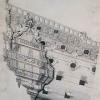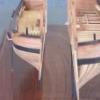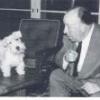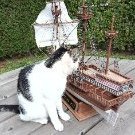-
Posts
3,084 -
Joined
-
Last visited
Reputation Activity
-
 Jaager reacted to usedtosail in Strip storage
Jaager reacted to usedtosail in Strip storage
I just implemented this method, using 2" square by 25" square mailing boxes. I cut a section of the top off so I can get the full length strips in the boxes.
I bought these on Amazon.
-
 Jaager got a reaction from Nirvana in Workshop Advice
Jaager got a reaction from Nirvana in Workshop Advice
1. From my research lab days : bench space, bench space, bench space -- you can never have enough bench space.
Three walls and you have space for 3 benches. Have one higher than desk height.
Inexpensive flush interior doors - make good bench tops - glue on a plastic/vinyl surface. They come in variety of widths.
The deeper - the better you will like it. Cheap cabinet units and 2 drawer file cabinets make good bench top supports.
The tools you have will produce a LOT of dust.
2. If you can manage it - have the vac as far away ( and outside if possible ) I have no experience with Festool - but everything else
is noisy. I have to use occlusive head phone type protectors. You can have ABS piping in the ceiling going to the vac. One of the guys here
has photos of his setup with the solid vac pipes - with shut off valves since he has exhaust dedicated to each machine.
3. A cyclone trap in line will save you from having to clean the vac filter very often. You will probably be glad you did, if you get a vac that is
more powerful than you think you will need.
4. You can never have enough light.
5. Lots of shelves - high up on the walls.
-
 Jaager got a reaction from mischief in Workshop Advice
Jaager got a reaction from mischief in Workshop Advice
1. From my research lab days : bench space, bench space, bench space -- you can never have enough bench space.
Three walls and you have space for 3 benches. Have one higher than desk height.
Inexpensive flush interior doors - make good bench tops - glue on a plastic/vinyl surface. They come in variety of widths.
The deeper - the better you will like it. Cheap cabinet units and 2 drawer file cabinets make good bench top supports.
The tools you have will produce a LOT of dust.
2. If you can manage it - have the vac as far away ( and outside if possible ) I have no experience with Festool - but everything else
is noisy. I have to use occlusive head phone type protectors. You can have ABS piping in the ceiling going to the vac. One of the guys here
has photos of his setup with the solid vac pipes - with shut off valves since he has exhaust dedicated to each machine.
3. A cyclone trap in line will save you from having to clean the vac filter very often. You will probably be glad you did, if you get a vac that is
more powerful than you think you will need.
4. You can never have enough light.
5. Lots of shelves - high up on the walls.
-
 Jaager got a reaction from Seventynet in Workshop Advice
Jaager got a reaction from Seventynet in Workshop Advice
1. From my research lab days : bench space, bench space, bench space -- you can never have enough bench space.
Three walls and you have space for 3 benches. Have one higher than desk height.
Inexpensive flush interior doors - make good bench tops - glue on a plastic/vinyl surface. They come in variety of widths.
The deeper - the better you will like it. Cheap cabinet units and 2 drawer file cabinets make good bench top supports.
The tools you have will produce a LOT of dust.
2. If you can manage it - have the vac as far away ( and outside if possible ) I have no experience with Festool - but everything else
is noisy. I have to use occlusive head phone type protectors. You can have ABS piping in the ceiling going to the vac. One of the guys here
has photos of his setup with the solid vac pipes - with shut off valves since he has exhaust dedicated to each machine.
3. A cyclone trap in line will save you from having to clean the vac filter very often. You will probably be glad you did, if you get a vac that is
more powerful than you think you will need.
4. You can never have enough light.
5. Lots of shelves - high up on the walls.
-
 Jaager got a reaction from Canute in Workshop Advice
Jaager got a reaction from Canute in Workshop Advice
1. From my research lab days : bench space, bench space, bench space -- you can never have enough bench space.
Three walls and you have space for 3 benches. Have one higher than desk height.
Inexpensive flush interior doors - make good bench tops - glue on a plastic/vinyl surface. They come in variety of widths.
The deeper - the better you will like it. Cheap cabinet units and 2 drawer file cabinets make good bench top supports.
The tools you have will produce a LOT of dust.
2. If you can manage it - have the vac as far away ( and outside if possible ) I have no experience with Festool - but everything else
is noisy. I have to use occlusive head phone type protectors. You can have ABS piping in the ceiling going to the vac. One of the guys here
has photos of his setup with the solid vac pipes - with shut off valves since he has exhaust dedicated to each machine.
3. A cyclone trap in line will save you from having to clean the vac filter very often. You will probably be glad you did, if you get a vac that is
more powerful than you think you will need.
4. You can never have enough light.
5. Lots of shelves - high up on the walls.
-
 Jaager got a reaction from WackoWolf in Workshop Advice
Jaager got a reaction from WackoWolf in Workshop Advice
1. From my research lab days : bench space, bench space, bench space -- you can never have enough bench space.
Three walls and you have space for 3 benches. Have one higher than desk height.
Inexpensive flush interior doors - make good bench tops - glue on a plastic/vinyl surface. They come in variety of widths.
The deeper - the better you will like it. Cheap cabinet units and 2 drawer file cabinets make good bench top supports.
The tools you have will produce a LOT of dust.
2. If you can manage it - have the vac as far away ( and outside if possible ) I have no experience with Festool - but everything else
is noisy. I have to use occlusive head phone type protectors. You can have ABS piping in the ceiling going to the vac. One of the guys here
has photos of his setup with the solid vac pipes - with shut off valves since he has exhaust dedicated to each machine.
3. A cyclone trap in line will save you from having to clean the vac filter very often. You will probably be glad you did, if you get a vac that is
more powerful than you think you will need.
4. You can never have enough light.
5. Lots of shelves - high up on the walls.
-
 Jaager got a reaction from Alan Cabrera in First carving attempt by Joop
Jaager got a reaction from Alan Cabrera in First carving attempt by Joop
Too late, but a stress free and precise way to drill the holes:
For small subjects, temp bond the piece to a base, mark/start the holes with a very sharp awl
and drill the holes with a drill press.
It avoids the twitch problem with free hand drilling as well as doing the hole perpendicular.
I find that the bits want to dance on the surface, and the awl produced pit avoids that.
-
 Jaager got a reaction from flying_dutchman2 in First carving attempt by Joop
Jaager got a reaction from flying_dutchman2 in First carving attempt by Joop
Too late, but a stress free and precise way to drill the holes:
For small subjects, temp bond the piece to a base, mark/start the holes with a very sharp awl
and drill the holes with a drill press.
It avoids the twitch problem with free hand drilling as well as doing the hole perpendicular.
I find that the bits want to dance on the surface, and the awl produced pit avoids that.
-
 Jaager got a reaction from EricWilliamMarshall in First carving attempt by Joop
Jaager got a reaction from EricWilliamMarshall in First carving attempt by Joop
Too late, but a stress free and precise way to drill the holes:
For small subjects, temp bond the piece to a base, mark/start the holes with a very sharp awl
and drill the holes with a drill press.
It avoids the twitch problem with free hand drilling as well as doing the hole perpendicular.
I find that the bits want to dance on the surface, and the awl produced pit avoids that.
-
 Jaager got a reaction from Hubac's Historian in First carving attempt by Joop
Jaager got a reaction from Hubac's Historian in First carving attempt by Joop
Too late, but a stress free and precise way to drill the holes:
For small subjects, temp bond the piece to a base, mark/start the holes with a very sharp awl
and drill the holes with a drill press.
It avoids the twitch problem with free hand drilling as well as doing the hole perpendicular.
I find that the bits want to dance on the surface, and the awl produced pit avoids that.
-
 Jaager got a reaction from dgbot in First carving attempt by Joop
Jaager got a reaction from dgbot in First carving attempt by Joop
Too late, but a stress free and precise way to drill the holes:
For small subjects, temp bond the piece to a base, mark/start the holes with a very sharp awl
and drill the holes with a drill press.
It avoids the twitch problem with free hand drilling as well as doing the hole perpendicular.
I find that the bits want to dance on the surface, and the awl produced pit avoids that.
-
 Jaager got a reaction from Joop-Ham in First carving attempt by Joop
Jaager got a reaction from Joop-Ham in First carving attempt by Joop
Too late, but a stress free and precise way to drill the holes:
For small subjects, temp bond the piece to a base, mark/start the holes with a very sharp awl
and drill the holes with a drill press.
It avoids the twitch problem with free hand drilling as well as doing the hole perpendicular.
I find that the bits want to dance on the surface, and the awl produced pit avoids that.
-
 Jaager got a reaction from Martin W in Carving tools, books and carving woods discussion
Jaager got a reaction from Martin W in Carving tools, books and carving woods discussion
Mike,
Swiss Pear is not a variety of pear. Pyrus communis is the common European Pear.
It is used as root stock for fruit pear varieties? The tree itself does not produce desirable
fruit but is a horticultural specimen? If the wood is steamed, it turns a uniform pink.
This treatment is the "Swiss" part. I believe that the wood from any type of pear -
Asian or European is excellent for any part of a wooden ship model: from keel and
frames to spars. If your stock did not split and check into useless fragments as it
dried or bark beetles did not mine it out , you may come to regret shortening the pieces.
Most any pear wood has a color that looks good as keel, frames and planking. It is
hard, tight grained, does not easily split if you carve against the grain - and seems
almost ivory-like in consistency.
When I posted earlier about Bradford Pear not having tight grain, that was the wrong term,
what I meant was that the tree grows rapidly - so the bands of Spring and Summer woods are
wide. For some parts it is possible to have what shows be grain free - all of one season. I have a bit of
Boxwood from an old hedge that had grown very slowly. The rings are very narrow and very
close together.
-
 Jaager got a reaction from WackoWolf in Carving tools, books and carving woods discussion
Jaager got a reaction from WackoWolf in Carving tools, books and carving woods discussion
Mike,
Swiss Pear is not a variety of pear. Pyrus communis is the common European Pear.
It is used as root stock for fruit pear varieties? The tree itself does not produce desirable
fruit but is a horticultural specimen? If the wood is steamed, it turns a uniform pink.
This treatment is the "Swiss" part. I believe that the wood from any type of pear -
Asian or European is excellent for any part of a wooden ship model: from keel and
frames to spars. If your stock did not split and check into useless fragments as it
dried or bark beetles did not mine it out , you may come to regret shortening the pieces.
Most any pear wood has a color that looks good as keel, frames and planking. It is
hard, tight grained, does not easily split if you carve against the grain - and seems
almost ivory-like in consistency.
When I posted earlier about Bradford Pear not having tight grain, that was the wrong term,
what I meant was that the tree grows rapidly - so the bands of Spring and Summer woods are
wide. For some parts it is possible to have what shows be grain free - all of one season. I have a bit of
Boxwood from an old hedge that had grown very slowly. The rings are very narrow and very
close together.
-
 Jaager got a reaction from Canute in Carving tools, books and carving woods discussion
Jaager got a reaction from Canute in Carving tools, books and carving woods discussion
Mike,
Swiss Pear is not a variety of pear. Pyrus communis is the common European Pear.
It is used as root stock for fruit pear varieties? The tree itself does not produce desirable
fruit but is a horticultural specimen? If the wood is steamed, it turns a uniform pink.
This treatment is the "Swiss" part. I believe that the wood from any type of pear -
Asian or European is excellent for any part of a wooden ship model: from keel and
frames to spars. If your stock did not split and check into useless fragments as it
dried or bark beetles did not mine it out , you may come to regret shortening the pieces.
Most any pear wood has a color that looks good as keel, frames and planking. It is
hard, tight grained, does not easily split if you carve against the grain - and seems
almost ivory-like in consistency.
When I posted earlier about Bradford Pear not having tight grain, that was the wrong term,
what I meant was that the tree grows rapidly - so the bands of Spring and Summer woods are
wide. For some parts it is possible to have what shows be grain free - all of one season. I have a bit of
Boxwood from an old hedge that had grown very slowly. The rings are very narrow and very
close together.
-
 Jaager got a reaction from mtaylor in Carving tools, books and carving woods discussion
Jaager got a reaction from mtaylor in Carving tools, books and carving woods discussion
Mike,
Swiss Pear is not a variety of pear. Pyrus communis is the common European Pear.
It is used as root stock for fruit pear varieties? The tree itself does not produce desirable
fruit but is a horticultural specimen? If the wood is steamed, it turns a uniform pink.
This treatment is the "Swiss" part. I believe that the wood from any type of pear -
Asian or European is excellent for any part of a wooden ship model: from keel and
frames to spars. If your stock did not split and check into useless fragments as it
dried or bark beetles did not mine it out , you may come to regret shortening the pieces.
Most any pear wood has a color that looks good as keel, frames and planking. It is
hard, tight grained, does not easily split if you carve against the grain - and seems
almost ivory-like in consistency.
When I posted earlier about Bradford Pear not having tight grain, that was the wrong term,
what I meant was that the tree grows rapidly - so the bands of Spring and Summer woods are
wide. For some parts it is possible to have what shows be grain free - all of one season. I have a bit of
Boxwood from an old hedge that had grown very slowly. The rings are very narrow and very
close together.
-
 Jaager got a reaction from EricWilliamMarshall in Carving tools, books and carving woods discussion
Jaager got a reaction from EricWilliamMarshall in Carving tools, books and carving woods discussion
Barlett pear is a variety of eatable pear. It is actually a variety of Pyrus communis - the tree that is
the source of what is called Swiss Pear. Swiss Pear is not a tree name or growth location, it means that the wood
has been steamed. I believe this oxidizes the polyphenols in the wood - in any case - it turns the wood into
a relatively uniform pinkish color.
Bradford Pear is a cousin that is a horticultural specimen. It does not produce significant fruit, but it is urban hardy,
attractive flowers and grows relatively fast. Was or still is popular as a street tree. It has one unfortunate characteristic -
the branches leave the trunk at an acute angle - rather than horizontal. The more vertical form looks good and is
predictable from design point of view. The problem is that when the larger trees experience wind storms, the branches
peal like banana skins. A good way for us to get a lot of sizable lumber stock. The other part - if you self harvest it -
because of the branch angle, it is difficult to get much stock with right angle grain for knees or breast hooks.
Actually, I think most any species of Pear would produce excellent wood for our purposes, the problem is obtaining it.
-
 Jaager got a reaction from thibaultron in Laburnum anagyroides or "golden rain"
Jaager got a reaction from thibaultron in Laburnum anagyroides or "golden rain"
The grain looks bold and distinctive. I am thinking that it would not scale all that well
and could distract from the actual model it would be used on.
It may make an interesting base for a display cabinet.
It is hard enough to be used for structures that would be hidden or if it is closed pore -
painted.
It contains a toxin, so you may wish to avoid burning it -if the combustion products can
enter your breathing space.
-
 Jaager got a reaction from Canute in Laburnum anagyroides or "golden rain"
Jaager got a reaction from Canute in Laburnum anagyroides or "golden rain"
The grain looks bold and distinctive. I am thinking that it would not scale all that well
and could distract from the actual model it would be used on.
It may make an interesting base for a display cabinet.
It is hard enough to be used for structures that would be hidden or if it is closed pore -
painted.
It contains a toxin, so you may wish to avoid burning it -if the combustion products can
enter your breathing space.
-
 Jaager got a reaction from Baker in Laburnum anagyroides or "golden rain"
Jaager got a reaction from Baker in Laburnum anagyroides or "golden rain"
The grain looks bold and distinctive. I am thinking that it would not scale all that well
and could distract from the actual model it would be used on.
It may make an interesting base for a display cabinet.
It is hard enough to be used for structures that would be hidden or if it is closed pore -
painted.
It contains a toxin, so you may wish to avoid burning it -if the combustion products can
enter your breathing space.
-
 Jaager got a reaction from mtaylor in Laburnum anagyroides or "golden rain"
Jaager got a reaction from mtaylor in Laburnum anagyroides or "golden rain"
The grain looks bold and distinctive. I am thinking that it would not scale all that well
and could distract from the actual model it would be used on.
It may make an interesting base for a display cabinet.
It is hard enough to be used for structures that would be hidden or if it is closed pore -
painted.
It contains a toxin, so you may wish to avoid burning it -if the combustion products can
enter your breathing space.
-
 Jaager got a reaction from Robin Lous in Contact cement for hull plating
Jaager got a reaction from Robin Lous in Contact cement for hull plating
The original Model Shipways had a catalog with methods included. One of them
was to attach copper plates to a hull using Weldwood contact cement. They also
suggested heating the plates in a flame to give each plate a different shade and
remove the new penny look. I did both to the hull of the schooner Eagle.
The look was attractive to me. Then... after several years the plates began to fall
off. The wood behind the copper was copper colored.
I do not know if it was the copper or the oxidized layer that caused the bond failure.
I will not do that again though.
If I were of a mind to try that again, I would use a clear thin epoxy - as much of a PITA -
doing that much epoxy would be. It is definitely more involved than fixing eye bolts and such.
My current thinking is to use 100% rag bond dissertation paper, sealed and painted with actual copper
paint and attached with PVA. Then do the verdigris reaction step.
The adhesive backed foil looks much easier, but I do not trust the long term bond and it can't be heated
because of the adhesive.
-
 Jaager got a reaction from thibaultron in Contact cement for hull plating
Jaager got a reaction from thibaultron in Contact cement for hull plating
The original Model Shipways had a catalog with methods included. One of them
was to attach copper plates to a hull using Weldwood contact cement. They also
suggested heating the plates in a flame to give each plate a different shade and
remove the new penny look. I did both to the hull of the schooner Eagle.
The look was attractive to me. Then... after several years the plates began to fall
off. The wood behind the copper was copper colored.
I do not know if it was the copper or the oxidized layer that caused the bond failure.
I will not do that again though.
If I were of a mind to try that again, I would use a clear thin epoxy - as much of a PITA -
doing that much epoxy would be. It is definitely more involved than fixing eye bolts and such.
My current thinking is to use 100% rag bond dissertation paper, sealed and painted with actual copper
paint and attached with PVA. Then do the verdigris reaction step.
The adhesive backed foil looks much easier, but I do not trust the long term bond and it can't be heated
because of the adhesive.
-
 Jaager got a reaction from thibaultron in Bending with heat only
Jaager got a reaction from thibaultron in Bending with heat only
The components of the wood are not soluble in water. The function of
water in bending wood is:
to transfer heat more efficiently
to retain the heat longer
to inhibit the cooking or charring of the surface of the wood where the heat is applied.
With thin wood, the difference in heat transfer with and minus water may not be significant.
The balance is to apply enough heat to liquefy the lignin without oxidizing the wood.
The negative effect of water is that it swells the wood fibers and leaves a previously sanded
surface uneven. Most of the time, this swelling effect only occurs with the first exposure to water,
if water is applied, allowed to dry and then sanded - subsequent water usually does not swell the wood
any further.
To readdress a subject of folklore: aqueous/household ammonia does not help in bending - other than what
the water it is in does. The ammonia part only has negative effects.
It takes liquid ( anhydrous ) ammonia to debond lignin for bending. This is an industrial chemical: even if
a civilian could obtain it - that would be a really bad idea.
-
 Jaager got a reaction from Canute in Contact cement for hull plating
Jaager got a reaction from Canute in Contact cement for hull plating
The original Model Shipways had a catalog with methods included. One of them
was to attach copper plates to a hull using Weldwood contact cement. They also
suggested heating the plates in a flame to give each plate a different shade and
remove the new penny look. I did both to the hull of the schooner Eagle.
The look was attractive to me. Then... after several years the plates began to fall
off. The wood behind the copper was copper colored.
I do not know if it was the copper or the oxidized layer that caused the bond failure.
I will not do that again though.
If I were of a mind to try that again, I would use a clear thin epoxy - as much of a PITA -
doing that much epoxy would be. It is definitely more involved than fixing eye bolts and such.
My current thinking is to use 100% rag bond dissertation paper, sealed and painted with actual copper
paint and attached with PVA. Then do the verdigris reaction step.
The adhesive backed foil looks much easier, but I do not trust the long term bond and it can't be heated
because of the adhesive.



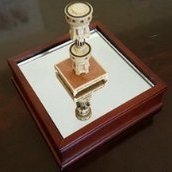





.thumb.jpeg.fc5d633a7b34428fcf19419a73d56d55.jpeg)
